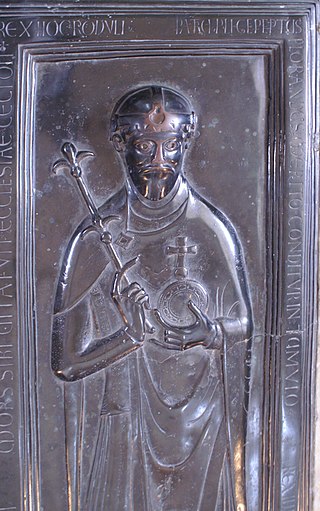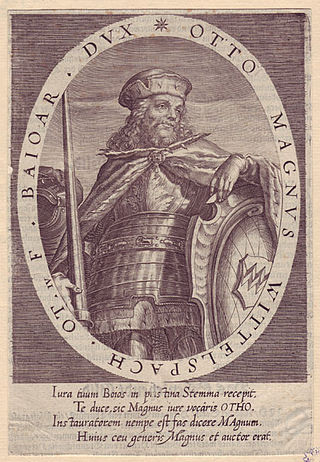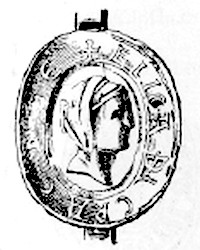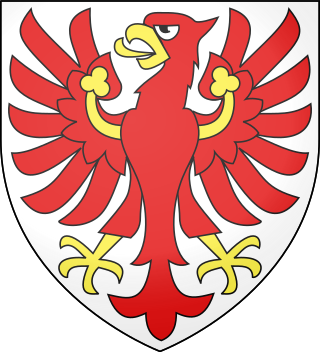
The House of Zähringen was a dynasty of Swabian nobility. The family's name derived from Zähringen Castle near Freiburg im Breisgau. The Zähringer in the 12th century used the title of Duke of Zähringen, in compensation for having conceded the title of Duke of Swabia to the Staufer in 1098. The Zähringer were granted the special title of Rector of Burgundy in 1127, and they continued to use both titles until the extinction of the ducal line in 1218.

Rudolf of Rheinfelden was Duke of Swabia from 1057 to 1079. Initially a follower of his brother-in-law, the Salian emperor Henry IV, his election as German anti-king in 1077 marked the outbreak of the Great Saxon Revolt and the first phase of open conflict in the Investiture Controversy between Emperor and Papacy. After a series of armed conflicts, Rudolf succumbed to his injuries after his forces defeated Henry's in the Battle on the Elster.

Otto I, called the Redhead, was Duke of Bavaria from 1180 until his death. He was also called Otto VI as Count Palatine of Bavaria from 1156 to 1180. He was the first Bavarian ruler from the House of Wittelsbach, a dynasty which reigned until the abdication of King Ludwig III of Bavaria in the German Revolution of 1918.

Frederick IV was Burgrave of Nuremberg from 1300, until his death in 1332. He was the younger son of Burgrave Frederick III from his second marriage with the Ascanian princess Helene of Saxony.

The (Princely) County of Tyrol was an estate of the Holy Roman Empire established about 1140. After 1253, it was ruled by the House of Gorizia and from 1363 by the House of Habsburg. In 1804, the County of Tyrol, unified with the secularised prince-bishoprics of Trent and Brixen, became a crown land of the Austrian Empire. From 1867, it was a Cisleithanian crown land of Austria-Hungary.

Berthold IV, a member of the House of Andechs, was Margrave of Istria and Carniola. By about 1180/82 he assumed the title of Duke of Merania, referring to the Adriatic seacoast of Kvarner which his ancestors had conquered in the 1060s and annexed to Istria and Carniola.

Otto I, a member of the House of Andechs, was Duke of Merania from 1204 until his death. He was also Count of Burgundy from 1208 to 1231, by his marriage to Countess Beatrice II, and Margrave of Istria and Carniola from 1228 until his death.
The House of Sponheim or Spanheim was a medieval German noble family, which originated in Rhenish Franconia. They were immediate Counts of Sponheim until 1437 and Dukes of Carinthia from 1122 until 1269. Its cadet branches ruled in the Imperial County of Ortenburg-Neuortenburg and various Sayn-Wittgenstein states until 1806.

The House of Andechs was a feudal line of German princes in the 12th and 13th centuries. The counts of Dießen-Andechs obtained territories in northern Dalmatia on the Adriatic seacoast, where they became Margraves of Istria and ultimately dukes of a short-lived imperial state named Merania from 1180 to 1248. They were also self-styled lords of Carniola.

Berthold III, a member of the Bavarian House of Andechs, was Margrave of Istria from 1173 until his death.

The Counts of Ortenburg were a comital family in the mediaeval Duchy of Carinthia. Though they had roots in Bavarian nobility, an affiliation with the Imperial Counts of Ortenburg, a branch line of the Rhenish Franconian House of Sponheim, is not established.
Berthold VII, Count of Henneberg-Schleusingen was Count of Henneberg- Schleusingen from 1284 to 1340. He was the son of Count Berthold V of Henneberg-Schleusingen and his wife Sophie of Schwarzburg, the daughter of Count Günther VII of Schwarzburg. He was confirmed as Imperial Prince by Emperor Henry VI in 1310.
Agnes of Hohenstaufen was the daughter and heiress of the Hohenstaufen count palatine Conrad of the Rhine. She was Countess of the Palatinate herself from 1195 until her death, as the wife of the Welf count palatine Henry V.

Agnes of Loon (1150–1191), was a duchess consort of Bavaria, married to Otto I of Wittelsbach, Duke of Bavaria. She was regent of Bavaria during the minority of her son, Louis I, Duke of Bavaria, from 1183 to 1191.

Heilika of Pettendorf-Lengenfeld was by marriage Countess Palatine of Bavaria.

Albert IV was Count of Tyrol from 1202 until his death, the last from the original House of Tirol. He also served as Vogt of the bishoprics of Trent and Brixen.
Berthold I was Count of Tyrol from about 1165 until his death.
Simon I of Saarbrücken was a German nobleman. He was the second ruling Count of Saarbrücken (de), in office 1135 - 1183.
Albert II was a progenitor of the Albertine House of Tyrol. He was documented as a count ruling the Bavarian estates in the Inn, Wipp and Eisack valleys of the Eastern Alps.

The Duchy of Merania was a fiefdom of the Holy Roman Empire from 1152 until 1248. The dukes of Merania were recognised as princes of the Empire enjoying imperial immediacy at a time when these concepts were just coming into use to distinguish the highest ranks of imperial nobility.













